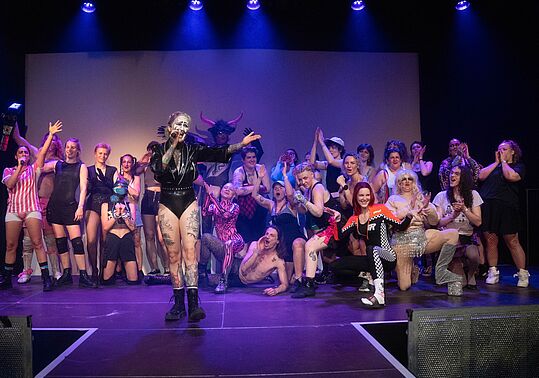Game theory in motion
What was your first encounter with game theory and what fascinates you about it?
Flóra Boros: During my double studies at the MUK and the University of Vienna I was constantly searching for ways to merge the two disciplines together. So when I first heard about game theory in an economy class it was clear for me that the model has been used in so many disciplines already. So why not try to implement it in dance? First I approached it theoretically, I wrote my thesis on the topic and later experimented kinesthetically. Ultimately I was curious how game theory can be implemented in performances, and that’s how my current work emerged.
Your piece CINDY is based on the study of mathematical models of strategic interactions among rational agents. At the same time it is inspired by the irrational and loopy pathways of a hurricane. How do these two concepts go together?
Flóra Boros: The connection came from an association of the game theoretical pattern I was exploring during my research. The movement quality and the spatial pathway that came from it reminded me of a hurricane. In the performance the pattern is displayed spatially by using light stripes as measurements, aiming to frame the playground of the body and leading to loopy pathways.
Later I realised that game theory is also implemented to deal with the aftermath of a natural disaster, such as a hurricane. The title is a reminder for me how it goes beyond being a “simple” mathematical model and is actually very multilayered, I still don’t know every application of it.
CINDY is an experiment that first breaks up kinesthetics, sounds and visuals into isolated scores, and then rearranges them back into a sensory representation of game theory. Which part in terms of your movement intrigued you more during your research work and why — the dissecting into isolated fragments or the reassembling?
Flóra Boros: Dissecting movements is always fun, especially because during this process I had the chance to forget my patterns. I have used it as an improvisational tool by creating rules and as a result a framework emerged organically from it. The improvisational tool that I experimented with during the movement research stuck with me in my daily practice. It allows me to view my body very analytically and free at the same time. It demands acceptance of, as it is a play between conscious and unconscious moments and movements. Unlike the elements of sound and lights, where preprogramming and live coding makes it possible to use chance and improvisation within a clear framework. Experimenting with the potential of how small a fragment can be in each element of the work was interesting to navigate.
Reassembling is a little game each time, we never know what will come out. During each try I aim to forget the previous outcomes in order to allow myself to get surprised and not to have a goal in mind. The tiny decisions might not be great, but that’s not important. I generally like to keep my work as free as possible and leave room for play therefore CINDY is a constant experiment.






